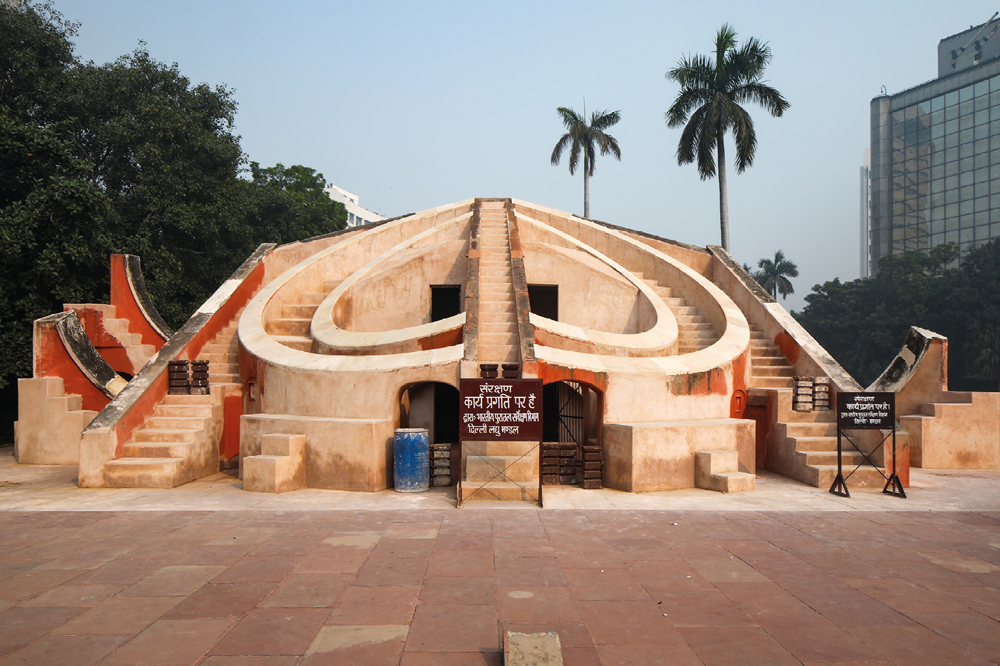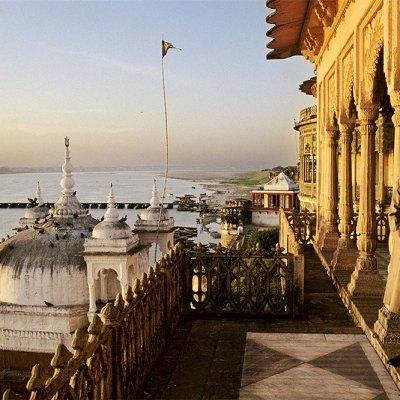The Jantar Mantar in Delhi is famous for its 13 astronomical instruments, construction of which began under Maharaja Sawai Jai Singh II (1688–1743) of Jaipur in the 1720s, and completed after his death. The park is empty when we visit and the giant triangle known as the Samrat Yantra, or Supreme Instrument, looms out of the heavy smog, as surreal and unsettling as a De Chirico painting. The dreamlike quality of these buildings-that-are-not-buildings has had a powerful influence on post-independence Indian architecture. These remarkable examples of Mughal technology spoke to an India freed from British rule, inspiring buildings that would usher in the future.
Near at hand is Kuldip Singh’s Palika Kendra building for New Delhi Municipal Council, where the brick, stone, marble and plaster of the Jantar Mantar have been scaled up and translated into monumental curves of shuttered concrete. The daring Shri Ram Centre by Shivnath Prasad is a short drive away. A rectangular rehearsal room is stacked on top of a cylindrical auditorium, a rational expression of different activities that also manages to look dangerously scaled up, one form cantilevering alarmingly over the other. Then there is Raj Rewal’s National Institute of Immunology of 1990 – a cluster of buildings and walkways that are both modern and regionalist, intimate yet grand. Rewal also appears to quote Jantar Mantar’s vertiginous stairways and complex geometries. Modern Indian architecture in all its grandeur is not on the usual tourist itinerary. But I am with the Twentieth Century Society, on its extraordinary India trip taking in four cities, organised with meticulous scholarship by its director Catherine Croft and Jon Wright of architectural firm Purcell, aided from time to time by the brilliant Elain Harwood of Historic England.
Three days later we are in Chandigarh, emotions running high as we arrive at the Capitol. To the west lies Le Corbusier’s great block of the Secretariat, and hard by it the Palace of Assembly with its massive floating portico. At the other end of the vast sun-baked Capitol Plaza, we see the High Court with its tripartite full-height entrances and daring curved facade. These are buildings as monumental sculpture, with the Himalayas as a backdrop (‘Look on my Works, ye Mighty, and despair!’). Coming closer, past the haunting, eye-catching Tower of Shadows, another building that appears to quote Jantar Mantar, it becomes clear that these ruins are inhabited. The internal spaces of the Assembly are glorious, as are the ramp and roof of the Secretariat, while the High Court bustles with lawyers. We came to worship – rightly so – but it is salutary to think of the great Indian architect Charles Correa, who was the master of the modest and provisional. He saw the Capitol’s drawbacks – Wagnerian buildings which were ill-adapted to purpose, which were in terms of Indian history, ‘one more in a series of monumental, cruel and wasteful happenings’.
Correa disliked the city itself. Yet Chandigarh seems delightful, leafy and ordered as we walk around Sector 22 and the Museum Complex, much of it a tribute to the ancillary work of Le Corbusier’s cousin Pierre Jeanneret, who spent the last two decades of his life in Chandigarh, training up a team of local architects, designing everything from manhole covers to furniture and, with Maxwell Fry and Jane Drew, 14 species of housing based on the salary and rank of government employees – what Correa saw as a medieval segregation of social classes, reminiscent of New Delhi. We make our way to Pierre Jeanneret’s own house – house type 4-J, in the most privileged zone of the city. It is quietly beautiful with brick screens and curved rubble walls, one pierced with a window in the form of an eye, lonely in its spacious garden.
Grandeur and intimacy jostle in post-independence Indian architecture. The very rich commandeered Le Corbusier as villa builder. In the city of Ahmedabad we visit the lovely Villa Sarabhai, deep in a 20-acre family compound, all light and shade, full of works of art, archaic yet modern, rus in urbe. With the architect Rabindra Vasavada we wander through Louis Kahn and Mahendra Raj’s Indian Institute of Management. Not since the Romans has structural brick been used to such effect. Many of these buildings are in danger of demolition or alteration. But they are all recorded in the excellent Indian Architectural Travel Guides published by Altrim. Just to visit them is a form of support.
From the January 2020 issue of Apollo. Preview and subscribe here.



